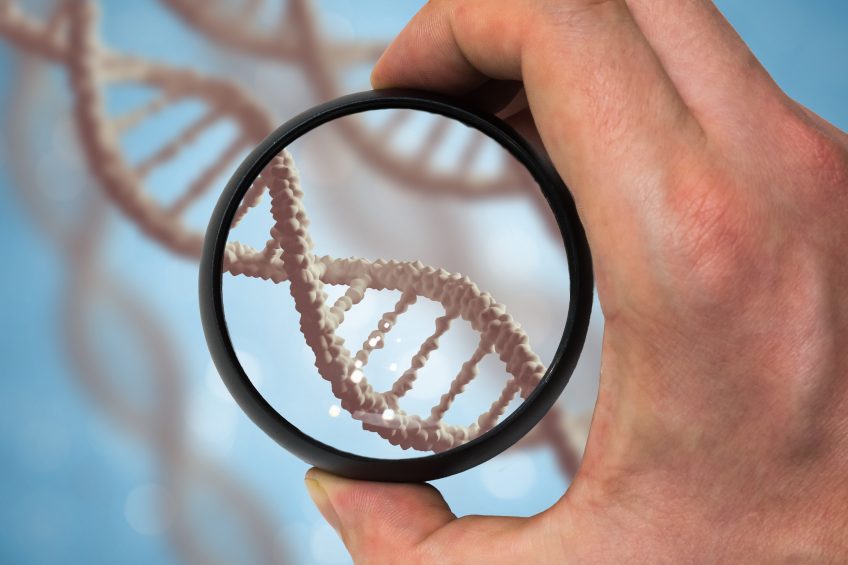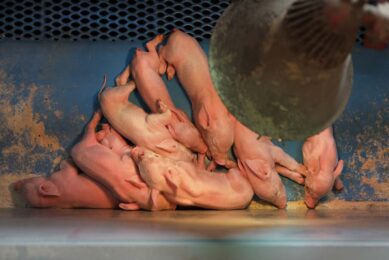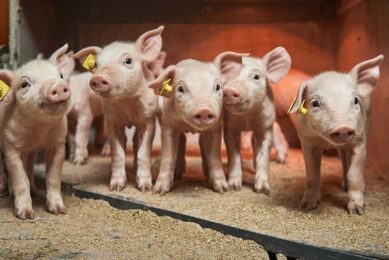Impact of genetics on weaning process

Genetic progress in sow fertility became significant in the 1990’s due to breeding technology (BLUP*). While before progress was stuck around 0.05 piglet/year, genetic progress in most breeding companies now reach levels of 0.3 to 0.4 piglets per year. No wonder that about 2 decades later ‘weaning traits’ have risen in importance for genetic improvement.
Whether piglets survive after birth depends on a large number of aspects. A part depends on the piglet quality, another part depends on the characteristics of the sow and a third part depends on the interaction between sow and piglets. To understand how to optimise the weaning process one has to evaluate the most important traits that characterise all of these categories. There is an extensive list of traits that all play a role in the process of getting pigs weaned after birth.
Of course it is not only genetics that play a role. The variation of a trait, where basic additive inheritance plays a role, is expressed as its heritability. Although many traits connected to weaning pigs have relatively low heritability’s (0.05-0.30), the genetic composition at herd level determines the base performance and the variation in performance. The non-genetic part is mainly environmental and this can be steered through other disciplines. For example, health or nutritional supplements, housing, equipment or climate related interventions can be used to repair or mask impaired pig or sow quality characteristics. Ultimately, it is a complex mix of many characteristics, which starts with genetics at the base. Genetics determines both the base and the maximum potential of an animal’s performance. Additionally, it appears that the more uniform the genetic background of a herd is, the easier and more predictable it can be steered.
To understand how to improve the process of weaning pigs the definition of the trait concerned needs to be determined. Weaning performance of a sow can be expressed, for example, as percentage of pigs weaned, of all pigs provided after birth (piglets born alive plus cross-fostered). For the piglet, logically, this is the probability that it survives until the moment of weaning. Ultimately, the focus is on getting pigs from birth to weaning, a term coined ‘weaning performance’.
Changes bring new challenges
A few decades ago weaning performance was a completely different trait compared to what it is today. Weaning 10 piglets is considerably different to weaning 16 piglets. Different challenging levels logically reveal diverse limiting factors that need to be watched and controlled. As the number of piglets weaned increases, the challenges for both sow and piglets differentiates. A prime example is the number of teats on a sow. In the 1980’s the number of teats on a sow was considered acceptable when there were more than 12 or 13 functional teats. It is easy to understand that recent performance levels in sow reproduction requires a higher number of teats as well as higher milk production levels. Nowadays focusing on 16 teats seems more logical. Breeding for number of teats is quite feasible (heritability 0.1-0.3), but the main thing is to keep the progress made in line with improved reproductive performances.
This is why in nucleus herds it is fairly common to challenge the younger generation to reveal its limiting factors and determine the traits that most likely will gain importance in the future. Unless future farming systems are considered, where piglets are weaned artificially in motherless environments, the focus needs to be on sow herds where the sows can wean their born piglets. If we want sows and piglets to do the job together, this brings us back to the importance of balanced breeding. Regardless of the development of farming systems a modern breeding programme can, by establishing the right challenging environment, provide the right genetic improvements to make modern sows and piglets flourish in production performance.

Survival rates of piglets
Piglet survival is of utmost importance to optimise weaning performance. Pre-weaning survival is partially determined by piglet birth weight. Piglet birth weight is quite heritable, but negatively correlated with litter size. It requires a specific approach in breeding programmes to maintain birth weights and litter uniformity, while increasing litter size. Besides this, piglets weighing less than 800 grammes appear to have a lower survival rate and when they survive, they provide lower margins. At birth, piglets need to be active enough to take in sufficient colostrum. Colostrum intake is related to immunity of herd specific diseases.
Another aspect of piglet survival is disease resistance ,or even better, disease resilience. During the pre-weaning phase, numerous kinds of diarrhoea’s challenge the piglets. Bacterial diarrhoea’s are mainly caused by E.coli or Clostridium. Other causes can be viruses like TGE, PRRS and PED. Especially some bacterial variants have been linked to genetic resistance. For enterotoxigenic E.coli with F4 and F18 fimbrial adhesion, genetic resistance is known. The first type is more focused on pre-weaning diarrhoea, while the last mainly focuses on post-weaning diarrhoea. Resistance in these cases is linked to a lack of expression of related intestinal E.coli receptors. Some modern breeding programmes are focusing on a complete eradication of both types of E.coli-susceptible genes. Also, it was recently discovered that 40% of how piglets respond to a complex viral disease like PRRS can be explained genetically. The favourable WUR SSC4 genetic marker explained a 10% increase in weight gain and a similar percentage of reduced viremia after pigs were exposed to PRRS infection.
The modern sow
The sow is probably the most critical factor for weaning performance. It is needless to say that a modern sow needs different characteristics than a sow from a couple of decades ago. Litter sizes have increased tremendously. More piglets brings down the piglet birth weights. Selection for birth weight and litter size needs to be in balance to create a litter of piglets that has optimum survival potential. When the piglets are born it initially comes down to number of teats and colostrum production. Later it is about milk production. Although it is hard to measure milk production from sows, the difference in weight of 14 day old piglets compared to birth-weight is a pretty accurate indicator for milk production.
Weighing piglets at various stages has become routine in most genetic programmes. Another factor important for milk production is feed intake of the sow. Feed intake has a decent heritability (0.2-0.3). Since a higher milk production requires a higher feed intake, genetic programmes focus on increasing the sows feed intake capacity. Equipment to measure feed during lactation has been developed and implemented in several programmes. Feed intake also relates to the ability of a sow to maintain body condition. Loosing too much condition during lactation will have a negative impact on reproductive and weaning performance in the following parities and on sow longevity. Another important factor is the sows water uptake. High performing sows have a water intake of up to 40 litres per day. Limited, or no information, can be found on the heritability of this trait. Logically, this is one of the next steps in improving weaning performance.
Natural variation in performance
To discover the genetic potential of weaning, it is interesting to look at natural variation in weaning performance. The breed most well-known for extreme weaning performances is the Chinese Meishan. It is known for having large litters and both the sow and the piglet have some amazing capacities that contribute to improved weaning performance. Even extremely small piglets (less than 800 grammes) have the great ability to survive. It is thought that this is due to brown fat reserves, but this has never been confirmed. Also concerning the influence of the sow there has been quite some speculation focused on behaviour differences. The sow was meant to spend less time standing and to have fewer changes in posture during a day, but most probably the best explanation could be due to differences in milk composition.
Farmer and Robert summarised in 2003 differences in milk composition of Meishan and western breeds from various research projects worldwide. At day one, the milk of Meishan sows contains about 11% fat while western breeds might only average approximately 6%. Later in lactation the fat percentage levels become more comparable, 8.5% and 6.5% for Meishan and western breeds respectively. It seems logical that milk composition could be a key trait for piglet survival. Small piglets have limited feed intake capacity and will have a higher energy uptake when the provided resources are twice as concentrated.
Sow and piglet interaction
The impact of sow and piglet interaction on weaning performance is also quite well-known to have a genetic base. One of the major problems is piglet crushing. Sow behaviour around farrowing is heritable. Nervousness, frequently standing up and laying down together with less than optimal suckling behaviour creates significant losses due to crushing. Maternal behaviour gets continuous attention in maternal lines in breeding programmes. Piglet savaging is also one of the factors that determine weaning performance. Aggressiveness against piglets mainly occurs during the farrowing process, but can also remain in the period after farrowing.
A long-term vision brings us to the definition of weaning capacity. High weaning capacity means that you have a herd of a certain genetics that is able to have a large amount of pigs and has the capacity to wean. The latter is due to a sow that combines high prolificacy and longevity with excellent weaning and rebreeding performance. The sow needs to be perfectly balanced to stay in production and maintain high performance levels. The piglets also need to fit in and contribute. Desirable piglets have increased survival rates, high disease resistance and excellent resilience to cope with any disease it is exposed to. Weaning capacity can be expressed as piglets/sow/year or total weaned piglet weight/sow/year. It requires a balanced breeding with equal attention for piglet and sow traits and their interactions. Genetic programmes need to think generations ahead and understand how limiting factors can be repaired and the harmony between piglet and sow can be established and maintained.
*BLUP=Best Linear Unbiased Prediction
 Beheer
Beheer







 WP Admin
WP Admin  Bewerk bericht
Bewerk bericht